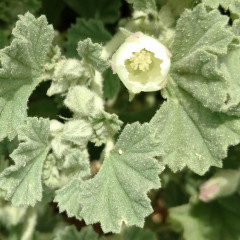
Alkali Mallow
Malvella leprosa. In contrast to annual mallows, alkali mallow is a perennial with deep extensive root system. White-hairy stem up to about 2′ long, spreading along the ground, hairs star shaped. Leaves alternate, fan or kidney shaped, lobed and wavy along edges, 0.5-2″ wide with asymmetric base stalks 0.5-1″ long. Five petal flowers with cup-shaped corolla up to 0.7″ long in shades of white or pale yellow.
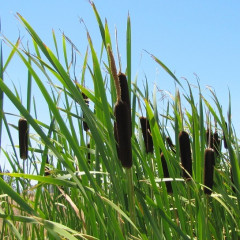
Common/Broadleaf Cattail
Typha latifolia. Obligate wetland in fresh water up to 2.6′ depth. Intrudes into marshes when salinity decreases. Up to 10′ tall with broad leaves ¾ to 1½ inch wide. Yellowish, club-like spike of tiny male flowers extending directly above a brownish cylinder of female flowers. Can block channels. Used as a bioremediator to absorb pollutants in water treatment ponds. Native Americans made baskets, canoes, pillows, and more. Birds use cottony seeds for nesting.
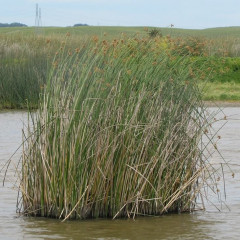
Common Tule/Bullrush, California Bullrush
Schoenoplectus (Scirpus) acutus, Schoenoplectus (Scirpus) californicus. Wetland obligate, in standing fresh water marshes. Rhizomatous, dense monotypic colony, 10′ tall. Stems 0.5-1.0″ thick. Terminal panicle inflorescence. Difference: California Tule – bright green triangular stems, Common Tule – grey green round stem. Used in wastewater treatment ponds for erosion control and host of beneficial soil bacteria. Native Americans used tules for housing, boats, clothes, food, and more.
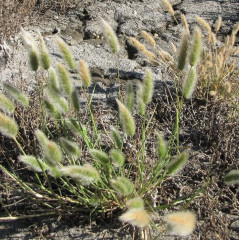
Rabbit Foot Grass, Annual Beard Grass
Polypogon monspeliensis. Clumping annual occurring in high brackish tidal marsh near pickleweed. Yellowish green leaves rolled in the bud, slender, flat, hairless. Pale green to light brown flower heads and seed heads have soft fur appearance. Sometimes planted as ornamental.
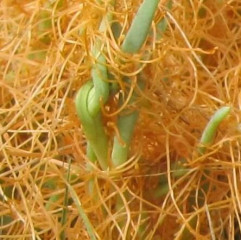
Saltmarsh Dodder
Cuscuta salina. Parasitic plant, tapping wetland plants for nutrients using penetrating haustoria. Conspicuous orange yellow wire like stems blanket hosts, usually broadleaf halophytic herbs and subshrubs (Pickleweed, Gumplant). Patches can be seen from planes.
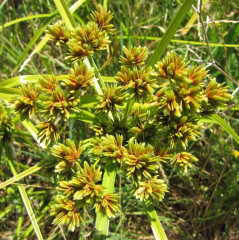
Umbrella Sedge, Tall Flatsedge
Cyperus eragrostis. Herbaceous grass-like perennial sedge from rhizomes found in riparian areas, ditches, damp grasslands. Can make 30 x 30′ clump. Green, triangular, tall, erect stems, 3-30″ tall. Long, thin, pointed leaves radiate from top. Summertime flowers in tough, rounded, greenish-yellow or beige spikelets. Prefers wet soil, clay or gravel, tolerates seasonal flooding. Weedy in rice fields.
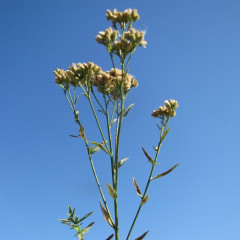
Marsh Baccharis
Baccharis glutinosa (douglasii). In high brackish marsh zone. Clonal colonies of erect, semi-woody herb 3-6′ tall with herbaceous shoots and few branches. Lance-shaped leaves up to 1′ long with short winged petioles. Small, white flowerheads in flat-topped clusters in summer, fall. Foliage and inflorescences resinous and sticky. Dioecious: males whitish staminate flowers, females fluffy whitish pistillate flowers.
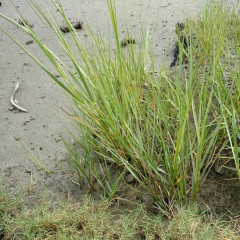
California Cord Grass
Spartina foliosa. In marsh edges, tidally submerged, in narrow bands. Perennial from short rhizomes. Single 30-120 cm tall white green stems. Leaf blades 618″ long, base 0.25-1″ wide, flat when fresh. Narrow spike inflorescence 5-10″ long. Gas transporting tubes for oxygen transport. Threatened by invasive Common Cord Grass. Hybrids with invader are even more vigorous than either parent.
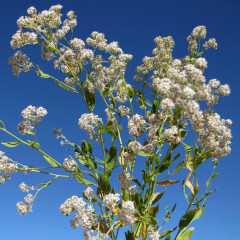
Perennial Pepperweed
Lepidium latifolium. Clonal perennial forb abundant in middle and high tidal brackish marsh zones and sub-saline seasonal wetlands. Numerous erect, semi-woody stems 2- 4′ tall originate from large, interconnected roots. Rosette leaves at first, then grows stems with lance shaped leaves getting smaller up stem. Small white flowers in dense clusters at tip of each stem. Becomes monoculture, outcompetes natives.
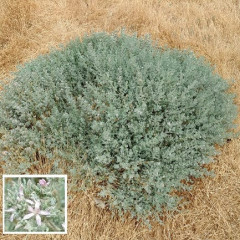
Alkali Heath
Frankenia salina. In high marsh, above Pickleweed. Round bushy shrub spreads by rhizomes. Tolerates salt and occasional flooding. Pores in small leaves secrete salt. Nectar is food source for insects. Habitat for small animals. Used in rock garden landscaping.
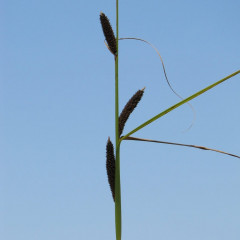
Basket Weave Sedge, Santa Barbara Sedge
Carex barbarae. Clonal sedge growing from rhizomes, found in riparian areas. Green, triangular stems, up to 3′ tall. Tough narrow leaves with shredding, red-spotted or purple basal sheath. Erect and drooping spikes up to about 3″ long with long bract exceeding length of spikes. Birds will eat seeds and use grass fibers for nesting. Used for stream bank stabilization, eco-restoration. Long rhizomes used for traditional basket weaving.
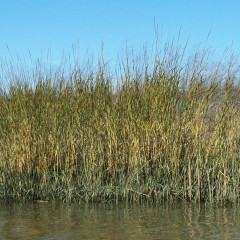
Salt-Water Cord Grass
Spartina alterniflora. Forms dense clonal stands in intertidal wetlands. Single 3-5′ maroon stems. Leaf blade 8-20″ long, base 0.25-1″ wide, flat when fresh. Narrow spike inflorescence, larger and produces more pollen than native. Hybridizes with native creating taller, more vigorous stands not suitable for shorebird habitat. SF Estuary Invasive Spartina Project monitors and sprays imazethapyr herbicide yearly.
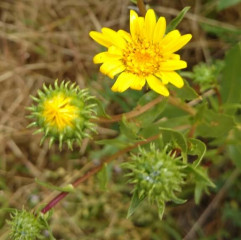
Pacific Gum Plant
Grindelia stricta. Bushy, highly branched subshrub with erect habit, over 1 m tall, grows in high tidal marsh zone. Fleshy deep green leaves, semi-evergreen. Gummy resinous flower heads with recurved phyllaries which can be chewed like gum (not tasty). Bright yellow daisy like flowers in open panicles. Used as modern-day medicine for poison oak rashes.

Pacific Rush, Spreading/Soft Rush
Juncus effusus. Juncus patens. Occurs in damp woods, bogs, wet pastures, and acidic soils. Thin round stems form thick clumps 1 m tall, with J. patens darker green and more definite ridges on stem. Rich brown color at base of stems. Many flowers form in compact spikelets located 2-4 cm from tip of stem. Used in low water landscapes. Stems used in basket weaving, mats, thatching, ropes
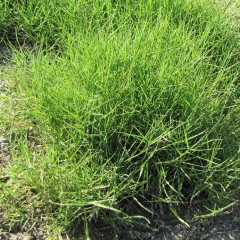
Salt Grass
Distichlis spicata. Perennial, forms dense clonal mats with rhizomes and stolons, 1-3′ tall, looks like Bermudagrass. Inhabits upper high marsh that is irregularly flooded. Tolerates alkaline and saline soils. Salt glands in leaves excrete salt crystals. Dioecious (male and female separate plants). Nesting for birds and food for birds, butterfly larvae, voles.
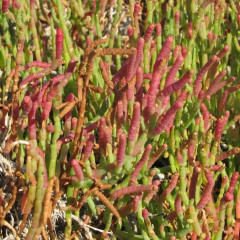
Pickleweed
Salicornia pacifica. Perennial halophylic (salt loving) herb in salt marshes and alkali flats. Compressed leaves attached end to end. Small white flowers. Salt is accumulated in leaf tips, turn green to red and die off. Food for birds and mammals, esp. Salt Marsh Harvest Mouse. Green leaves can be used in salads, steamed or pickled.

Marsh Jaumea
Jaumea carnosa. Found in low salt marsh, near pickleweed. Low perennial looks like a small Iceplant. Tolerates alkaline and saline soils and seasonal flooding. Succulent green opposite leaves on soft pinkish-green stems. Spreads by branching rhizomes. Small, fleshy yellow flowers. Boiled as a tea for fever; cooked and eaten as a vegetable.
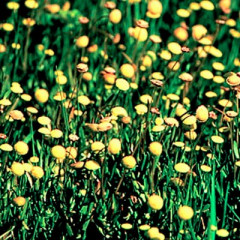
Brass-Buttons
Cotula coronopifolia. Found in muddy, anoxic (low oxygen) wetlands and brackish water, salt tolerant. Flat fleshy leaves store water during saline inundation. Red stems with green, blade shaped leaves with shiny cuticle (wax covering). Petal-less flower heads bright yellow discs look like buttons. Can reproduce by seeds or sprouting roots at stem joints.

Alkali/Saltmarsh Bullrush
Bolboschoenus (Scirpus) maritimus. Perennial in low to mid elevations in marshes. Large dense clonal stands. Tolerates alkaline (pH 9) and saline sites. Triangular stem, compact flowerheads with 3 long leaf like bracts. 1 cm wide, elongated leaves on bottom 2/3 of stem. Competes with tule and pickleweed.




